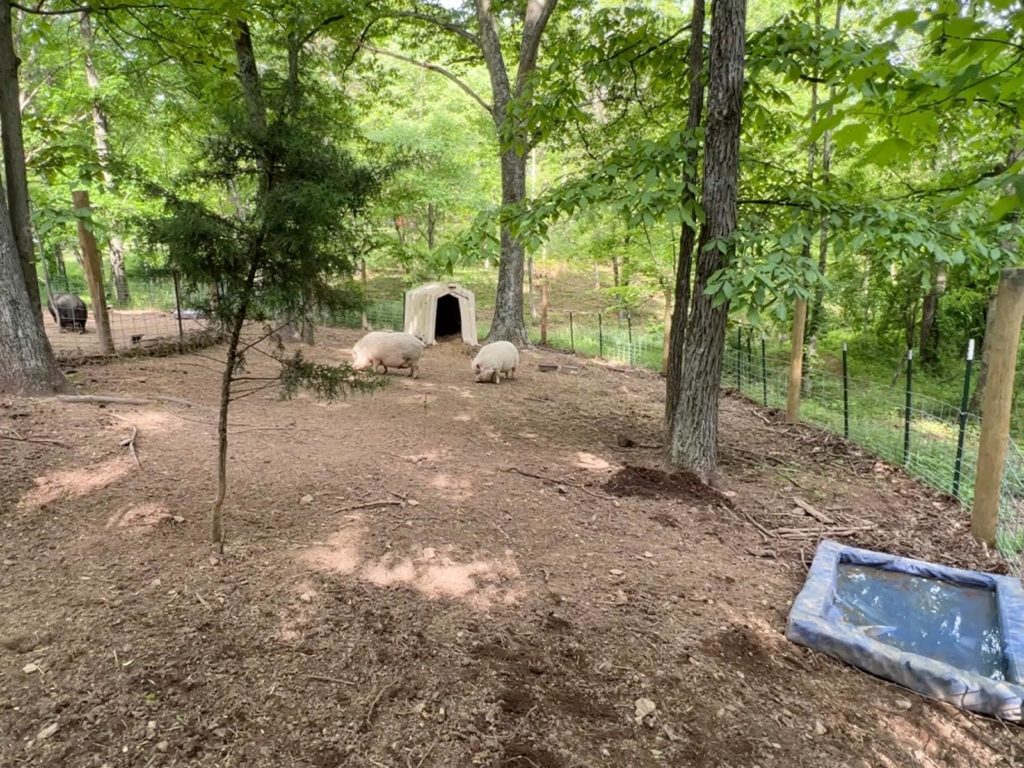When not rescuing pigs we love teaching people about them and how to properly care for them as pets. In this article we will be covering how to setup a comfortable living area for pigs to keep them happy and healthy.
Watch Our Video on Pig Pen Setups
Step 1: Location
The first thing to consider for your pig pen is the location. The pen should be constructed in an area where the pigs can dig, root, and tear up the ground without concern. Remember, pigs love to root! It keeps them active and occupied throughout their day. Rooting is their number one activity and you cannot (and should not) prevent it. Therefore you want to give your pigs an outdoor area where they can do so.
Secondly you want to be sure the pen location has areas of shade provided by trees or other structures. It is very important that your pig be able to get out of the direct sunlight when they choose.
Step 2: Fencing
Pigs are great escape artists so constructing your pen out of a solid fencing option is a must. We use hog or cattle panels sold at Tractor Supply Company. While expensive, they last forever and your pigs will not be able to bust through them. To build the pen, we place a treated post in the ground on each end of the hog panel, tack it in with barbed staples, and then place a 6ft t-post every four feet or so along the paneling for re-enforcement.
We cannot stress the importance of the hog paneling option. They are very strong and impossible to destroy by even the strongest pig. Using chicken wire or other type of wiring will not work as the pig will bust right through, or squeeze under it if smaller.
Step 3: Shelter
Your pig needs a dry area to stay in during bad weather and/or nighttime, so a quality housing option is a must. We like to use old used calf hutches, but any structure your pig can get into will work. Some options include large dog houses, old sheds, farm buildings, etc. We recommend attaching a flap of sorts to the shelter entry so the pig can get in / out but still has a barrier of protection from harsh weather.
No matter what type of shelter you choose for your pig, it is very important that you fill it full of straw, which is the preferred bedding for pigs. They love to make “nests” out of it and burrow down under it to get comfy. Straw also acts as a great insulator to provide them with warmth on cold nights. During very harsh winter months, throwing some old blankets and comforters into the pigs’s house is also a good idea for additional warmth.
Step 4: Water Area
An area where your pig can get fresh, clean water throughout the day is another requirement. You can use large water bowls, but be warned, most pigs enjoy flipping them over as soon as you fill them up (or shortly after when you are not paying attention). If you use water bowls, you will need to surround them with some sort of blocks that are tacked down into the ground preventing the pig from getting its snout under the water bowl (but still allowing you to empty, clean, and re-fill it).
Large wading / kiddie pools are also an option, but note some pigs do like to destroy them. We use custom made pig pools which are a type of watering hole. Basically it is a heavy foam wrapped in a tarp or durable plastic material creating a rectangular area where the pig can step in, get a drink, and step out easily. (Pig Pool Example)
Pig Pen Questions? Ask Us!
Our method of building pig pens is just one of the many options out there, but we have found it works great for all of our rescued pigs! If you have any specific questions, you can contact us, or leave a comment below and we will respond when we can.

